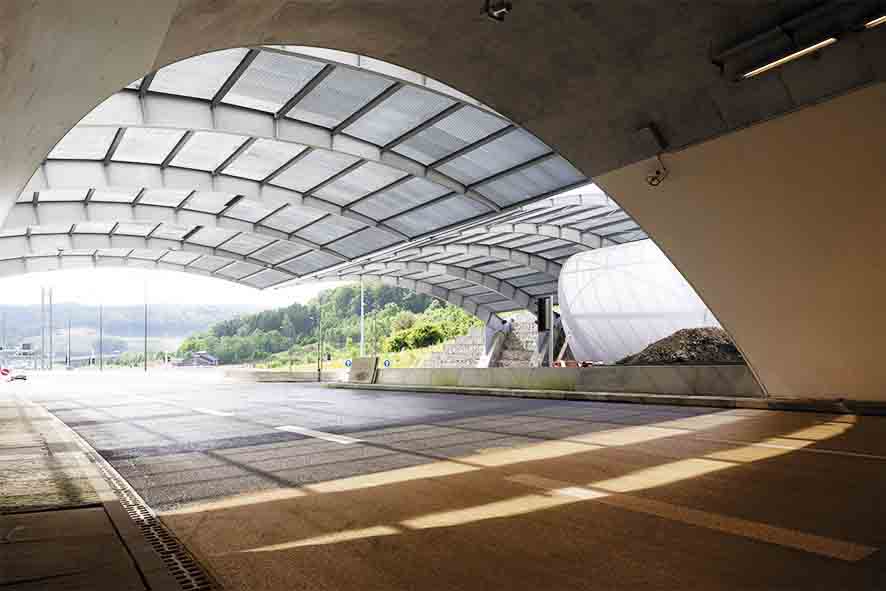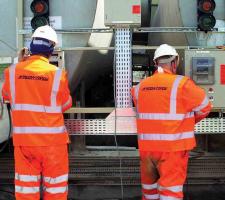
Shell Bitumen was chosen as the partner to provide the product for coloured pavements in two Luxembourg tunnels.
Luxembourg has a history of world-leading roads and tunnels, with one of the highest rates of investment and some of the best maintained, long-lasting roads in Europe.
For a recent project,
The company provided a lower temperature polymer-modified synthetic clear binder, Shell Mexphalte C LT (low temperature), for the project.
“The light colour of the asphalt is designed to help reduce lighting costs, and above all, improve the safety for users,” says Mickael Ferry of contractor Karp-Kneip.
The Shell Bitumen product was used to pave the 2,966m-long Grouft Tunnel and the 1,850m-long Stafelter Tunnel, both of which are twin bore.
The lower temperature formulation allows a decrease in laying temperature of up to 30°C, and this in turn reduces emissions from the asphalt significantly, providing a more comfortable working environment for those laying the pavement.
In total, Karp-Kneip layed 90,000m² of the coloured asphalt, and Shell provided an additional bitumen storage tank and special delivery trucks to meet the rapid on-site demand of 220tonnes of asphalt/hour.
“Using Shell Mexphalte C to produce an asphalt surfacing within a road tunnel can allow every alternate light to be switched off without reducing levels of visibility,” says Professor John Read, Shell Bitumen’s head of technology and research.
“It performs to a high standard and is widely used in materials that have to withstand heavy duty traffic. Many of the alternative products available are suitable for aesthetic use only.”
Linking Luxembourg City with the north of the country, the €700 million, 31.5km motorway opened in its entirety in September 2015, well over a decade after its first section opened.
Shell Bitumen says that thanks to their photometric qualities, synthetic binders have been used to pave many tunnels over the past few decades, including Toulon, France; Las Planas, Nice, France; Vernier and Confignon, Geneva, Switzerland, and Markusberg also in Luxembourg.
Meanwhile, level measuring specialists, Hycontrol, has designed and installed a multi-point bitumen level measuring and overfill protection system for
The system, utilising microwave and capacitive technologies, has been fitted to four 36.5tonne tanks containing hot bitumen, replacing the existing cat-and-mouse level system, an “out-of-date” mechanical arrangement, based on pulleys and counterweights.
The old system at Aggregate Industries’ Express Asphalt plant at Botley, near Southampton, southern England, was becoming increasingly maintenance-heavy, raising serious concerns about its long-term reliability.
The new Hycontrol instrumentation system has been designed to fall within strict budget restraints while meeting the latest Eurobitume/RBA (Refined Bitumen Association) guidelines designed to prevent spillages and accidents during the filling and operation of hot bitumen tanks.
RBA guidelines mandate that hot bitumen tanks must be fitted with a continuous level measuring system; a high level alarm and a totally independent high-high level alarm.
The accurate and reliable measuring of bitumen presents a number of challenges. Traditional ultrasonic technology cannot cope with the high temperatures, pressure changes and product build-up on the transducer heads encountered in such harsh environments.
Any invasive measurement technology can be susceptible to product build-up on the sensors, rapidly resulting in degradation in performance.
Hycontrol says it has extensive experience in providing effective RBA-compliant bitumen safety systems based on their Time Domain Reflectometry (TDR) technology, with its VF03 TDR sensors being unaffected by product build-up on the probes. Performance is also not affected by changes in pressure, temperature, dielectric constant or viscosity.
For this application, the bitumen levels are measured using Hycontrol’s high temperature VF03 TDR sensors, stainless steel probes that are usually fitted to flanges at the top of the tanks and extend down into the hot bitumen.
Hycontrol’s TDR technology, originally used to detect breaks in sub-sea communication cables, uses pulses of low-power microwaves sent along the conducting probes. At the point where the waves meet the air-product interface, they are reflected by the product back along the probe. The measured time between emission and reception back at the sensor head is proportional to the distance. This information is then converted to the level in the tank.














